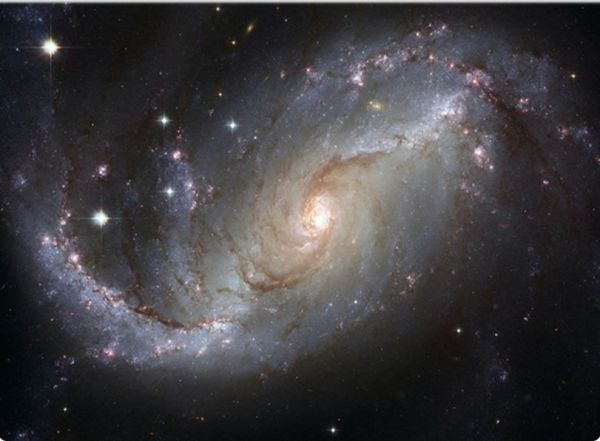
Arizona: A team of astronomers LED by University of Arizona Researcher Catherine Fielder Captured The Most Precise Photographs of A Small Galaxy and Its Surroundings, Revealing Features Typical Larger Galaxies.
Previously immagined
The Findings offer a rare and elusive look at how compact galaxies emerge and evolve, impleing that the Principles Driving Galaxy Growth May Be More General Than.
Galaxies, Including the Milky Way, Grow and Evolve by Merging with Smaller Galaxies Over Billions of Years in a Process Called Hierchical Assembly. This cosmic "Building Block" Approach has been well observed in large galaxies, where streams of ancient stars-remnants of swallowed-up galaxies-trace their turbulent history. These streams, ALONG SITER FAIN SUCTURES Such as Old, Form a So-Called Steller Halo: A Sprawling, Low-Dansity Cloud of Stars that surrounds of the brightests of a galaxy And traces its evolutionary history.
Gravitational pull
According to Traditional Wisdom, Smaller Galaxies Such as the Nearby Large Magellanic Cloud May Have Fewer Opportunities to Attract Mass and Merge With Smaller Systems, Including Osher Dawarf Galaxies, being of their weaker gravitational pull.
Understanding How Such Galaxies Acquire Mass and Grow in the Context of Hierchical Assembly Remains an open question.
Dark Energy Camera
The researchrs used the dark energy camera, or decam, on the 4-meter blanco telescope in chile’s cerro tololo inter -merican observation to conduct a deeep imaging surveyy of 11 darveyy of 11 darp Spiral Galaxy NGC 300, which is similar in mass to the large magellanic cloud.
The observations were made as part of the Decam Local Volume Survey, or delve, and reveled unprecedented details of NGC 300’s features.
Steller mass
Spanning About 94,000 light-yars, NGC 300’s Galactic Disk is a Little Smaller Than the Milky Way and Packs Only about 2 per cent 2 per cent of itstellar mass.
"NGC 300 is an Ideal Candidate for Such a Study because of its islated location," Said fielder, a research associate at the u of a steward observatorry.
Cosmic fossil record
"This keeps it free from the influential effects of a Massive Companion Like the Milky Way, which affects nearby small galaxies like the Large Magellanic Cloud. It’s almost a bit like looking at a cosmic ‘fossil record.’"
Fielder and her collaborators Created Steller Maps Around the Small Galaxy and Discovered a Vast Stellar Stream Extending More Than 100,000 Light-Years from the Galaxy’s Center.
Astrophysical journey
"We Consider a Steller Stream a TellTale Sign That A Galaxy Has Accreated Mass from its surrounddings, these these structures do’s Bollywood form as easily by internal processes," Said Fielder, Whoose Findings will be published in the Astrophysical Journal.
In addition, The Researchers found traces of stars arranged in Shell-Like Patterns Reminiscent of Concentric Waves Emanating from the Center of the Galaxy, as Well as Hints of a Stream Wrap-Evidence THETEVER CURP-EVIDENCE Stream may have changed direction in its orbit Around NGC 300.
"We Wena’T Sure We We WHEING TO Find Anything in Any of these small galaxies," She said.
"These features Around NGC 300 Provide us with ‘Smoking Gun’ Evidence that it Did Accrete Something."
The team also identified a previous unknown, metal-poor globular star cluster in the Galaxy’s Halo, Another "Smoking Gun" of Past Accretion Events.
Steller populations
When gauging the age of steellar populations, astronomers frequent turn to a feature know "metallicity" – A TERM Referring to the Chemical Elements Present Inside Stars. Because Heavier Elements are forged Mostly in more Massive Stars at or Near the end of their lifespans, it takes several generations of star formation to enrich thee elements.
Therefore, Stellar Populations Lacking Heavier Elements – Or Having Low Metallicity – Are presumed to be Older, Fielder Explained.
"The stars in the features we observe around NGC 300 Are Ancient and Metal-Poor, Telling a Clear Story," Fielder said.
"These structures likely originated from a tiny galaxy that was pulled apart and absorbed into NGC 300."
Dwarf galaxies
Togeether, these findings clearerly reveal that even dwarf galaxies can build stellar halos through the accretion of smaller galaxies, echoing the growing patterns seen in Larger Galaxies, FILEDER SAID.
"NGC 300 Now Stands as One of the most striking examples of accretion-Driven Stellar Halo Assembly in A Dwarf Galaxy of its Kind, Shedding Light on how Galaxies Grow and Evolevement."